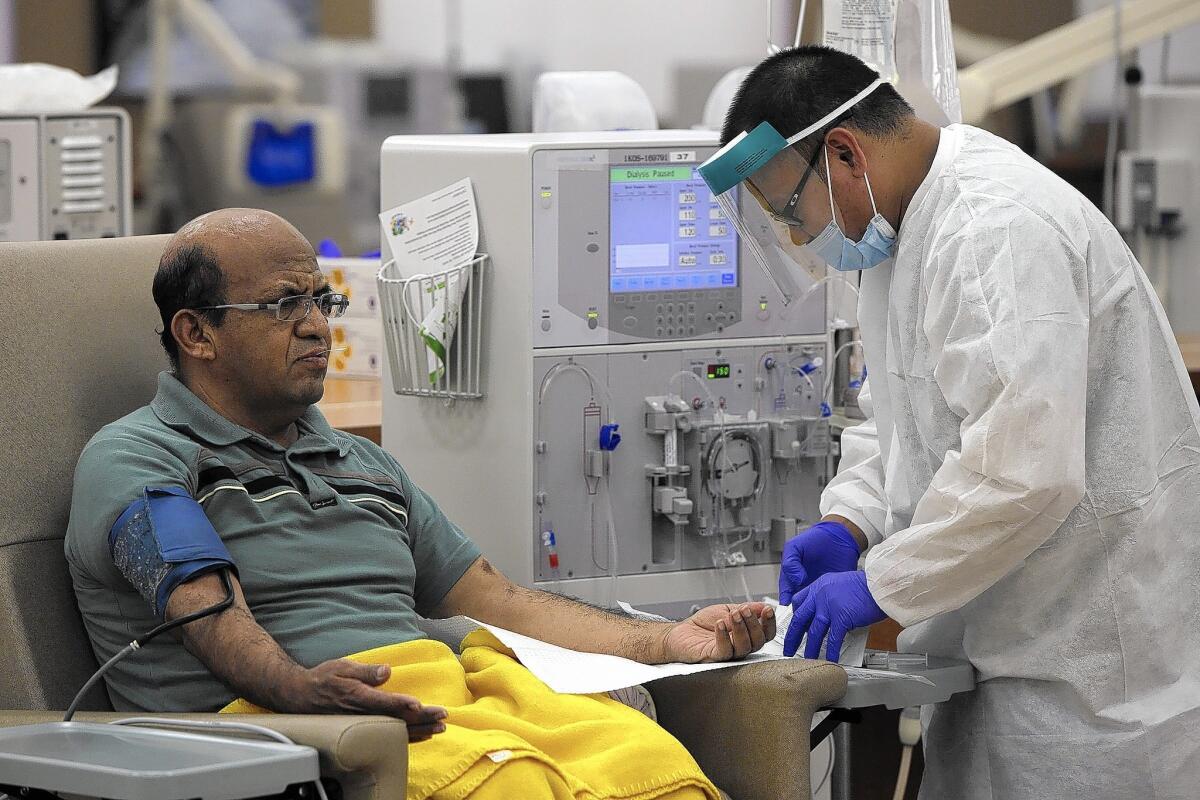Shortage of in-home dialysis solution has patients worried

- Share via
Unlike the hundreds of thousands of Americans who drive several times a week to a dialysis center, Joanna Galeas relies on an increasingly popular at-home alternative to treat her kidney failure.
Galeas, a 30-year-old Los Angeles resident, is among tens of thousands of U.S. residents who use peritoneal dialysis at home. She fills her abdomen with a sterile solution that helps remove toxins from her blood, a function ordinarily performed by healthy kidneys.
Now, Baxter International Inc., the nation’s leading supplier of the home dialysis solution, says it can’t keep up with demand and has started rationing the product, directing physicians to limit the number of new patients to whom they prescribe the treatment and reducing the size of shipments sent to existing customers.
Last week, Galeas’ shipment of the lifesaving solution didn’t arrive, she said. When she was down to her final dose, Baxter made an emergency shipment to her home.
“I was freaking out all weekend until Monday when it arrived,” she said.
Baxter, based in Deerfield, Ill., blamed the shortage on an unexpected increase in demand, which it said has outpaced its ability to produce the solution. The company said that the number of U.S. patients using dialysis solution increased 15% in the second quarter compared with a year earlier and that demand for the product “has never been stronger.”
The shortage comes as a record number of people in the United States rely on dialysis because their kidneys failed; the U.S. dialysis population has more than doubled since 1995 to more than 400,000.
The number of patients opting to treat themselves at home with peritoneal dialysis jumped 24% from 2008 to 2011, according to the U.S. Renal Data System.
The treatment is not only more convenient for patients but also less expensive for Medicare, which typically pays for it. Medicare spent an average of $87,945 on each dialysis center patient in 2011, compared with $71,630 for those who treated themselves at home with peritoneal dialysis, data show.
This is the latest in a string of drug shortages that have forced many hospitals, doctors and patients to scramble for drugs and crucial supplies, such as saline solution. The shortages are often caused by manufacturers experiencing product quality problems, with a lack of other companies to pick up the slack, according to a report this year by the U.S. Government Accountability Office.
Baxter said the dialysis solution shortage could last until early next year.
“We definitely consider this a critical situation,” said Valerie Jensen, associate director of the Food and Drug Administration’s drug shortage program. “The FDA is doing everything we can to address the problem.”
Without access to the dialysis solution, people with kidney disease can use the more traditional hemodialysis treatment, which is most often administered at outpatient clinics. In that treatment, a dialysis machine filters toxins from a patient’s blood.
Many patients prefer the convenience of peritoneal dialysis because it can be done at home or in the workplace and on their schedule, said Lori Hartwell, founder of Renal Support Network, a nonprofit that advocates for people with chronic kidney disease.
Jerry Adams, a 75-year-old retiree from Springfield, Ohio, lost a kidney during a childhood bout with scarlet fever. The health of his remaining kidney has been declining because of high blood pressure. After much research, he opted for the at-home therapy, only to be declined in August because of the Baxter shortage.
“I’m down in the dumps,” Adams said. “I just think about it a lot.”
Adams said he’s not comfortable visiting a clinic because he lives far from the city and would not want to drive after receiving the dialysis treatment.
“I don’t know how it affects you as far as your energy, and my wife doesn’t drive too good anymore,” he said.
Baxter intends to open a new manufacturing line in early 2015, which the company says will increase its production capabilities and “enable supply to return to a more predictable state.” In the meantime, Baxter has reached an agreement with the country’s only other manufacturer of the dialysis solution, Fresenius, to provide solution to Baxter clients.
The FDA is also reaching out to foreign suppliers in an effort to temporarily import the dialysis solution, the FDA’s Jensen said.
“We have taken multiple steps to ensure uninterrupted care for existing patients,” Baxter spokeswoman Christy Noland said in a statement. “The guidance to customers is to ensure current patients have uninterrupted access to therapy and that new patients should be started based on medical need.”
At the same time Baxter was struggling to keep up with increasing orders, the company announced Aug. 13 that it was voluntarily recalling two lots of the solution because they contained stainless steel, garment fiber and PVC particulate matter.
The company said the number of recalled units represented less than 1% of its annual global production and was not a contributing factor to the shortage. But Jensen said the recall “definitely worsened the situation.”
Nearly 400,000 people in the U.S. received hemodialysis at clinics in 2011, and about 30,000 people treated themselves at home with peritoneal dialysis, according to the U.S. Renal Data System.
Hartwell, who runs the patient support group, said she’s surprised that the modest increase has created supply problems for Baxter.
“Maybe they just had poor planning and underestimated it,” she said. “Whatever it is, it’s unfortunate.”
Galeas was growing concerned even before her shipment failed to arrive last week.
Shipments to her home were smaller, meaning her safety net was thinner. And the shipments were sometimes dropped off by commercial carriers, who did not bring them inside her home, the way Baxter’s delivery team does.
The shortage has been unnerving for Galeas because she cannot live without the treatments.
“This puts an extra level of stress in my life.”
Twitter: @spfeifer22
Twitter: @chadterhune
More to Read
Inside the business of entertainment
The Wide Shot brings you news, analysis and insights on everything from streaming wars to production — and what it all means for the future.
You may occasionally receive promotional content from the Los Angeles Times.












